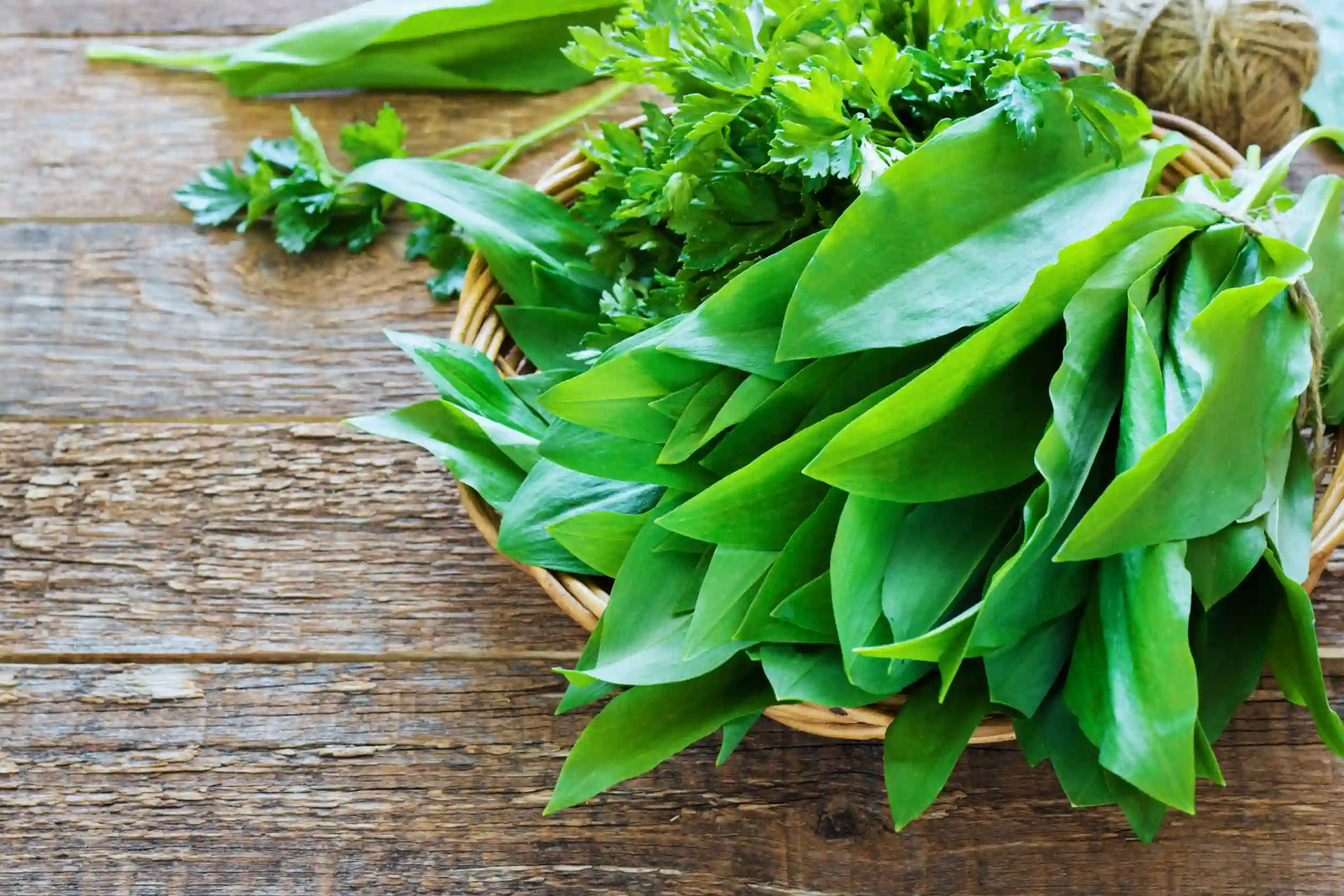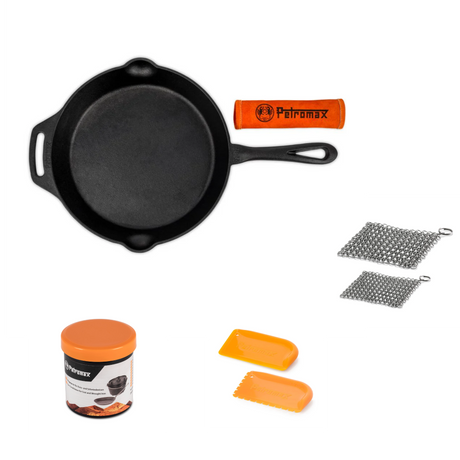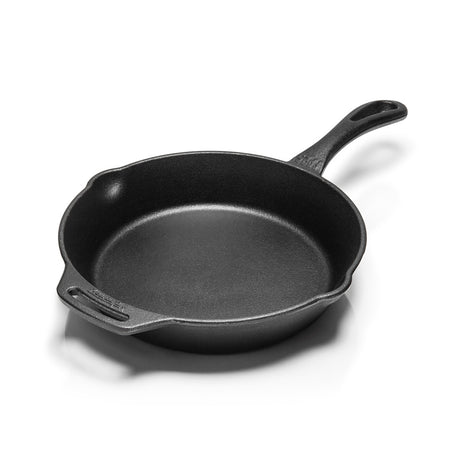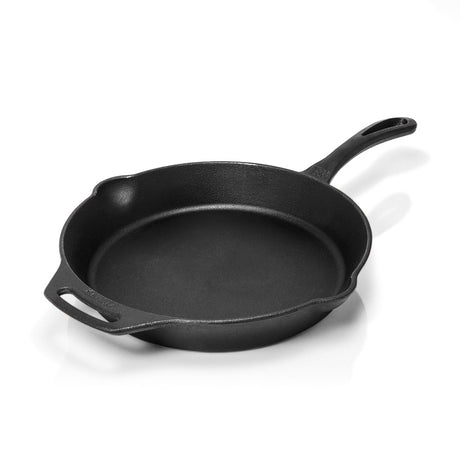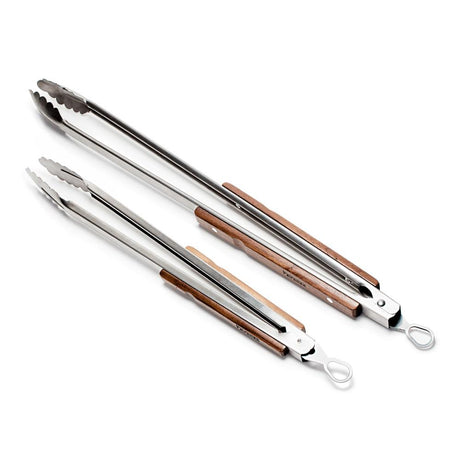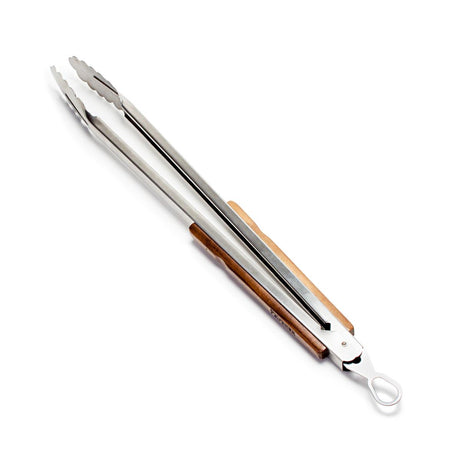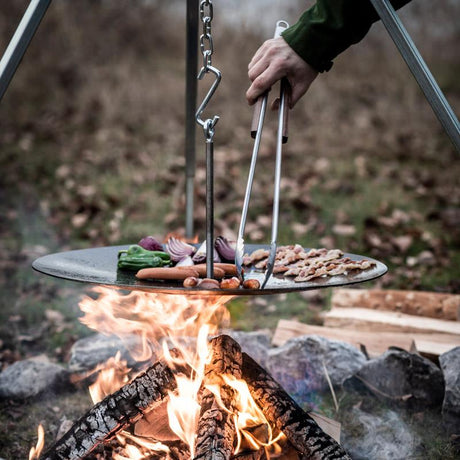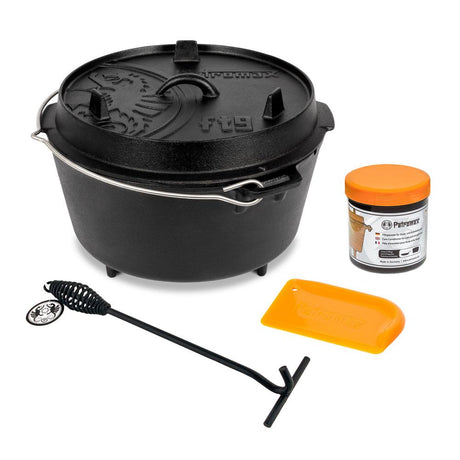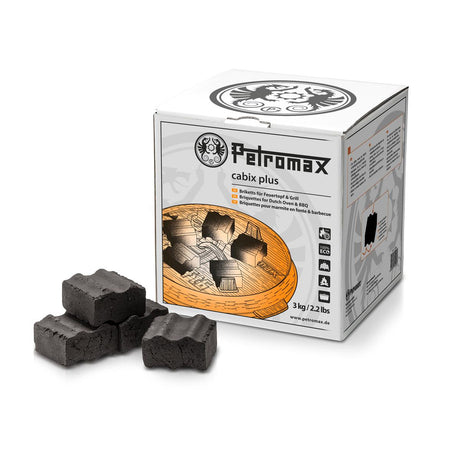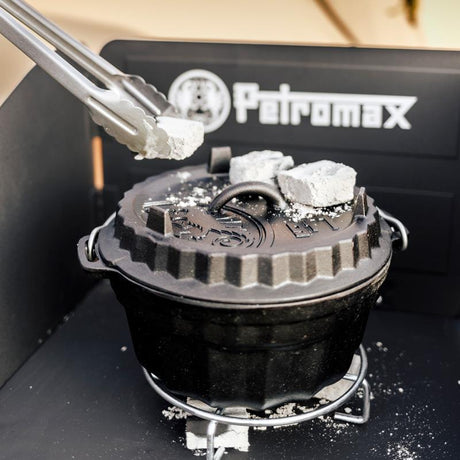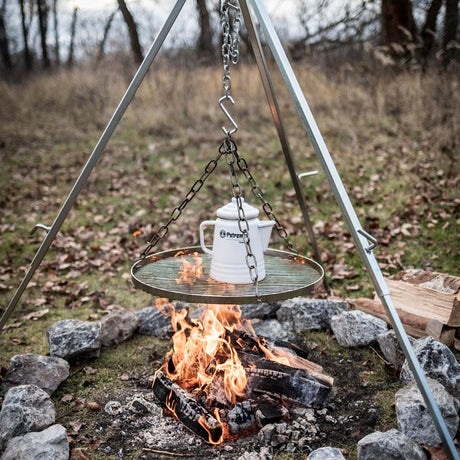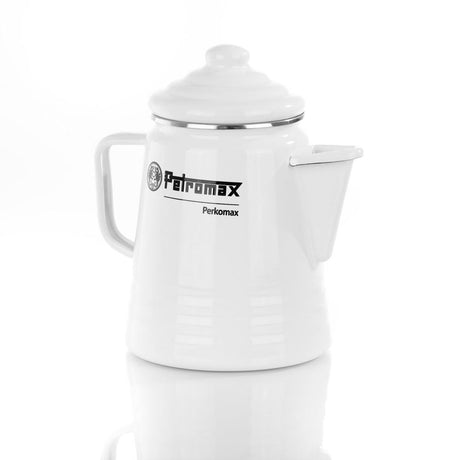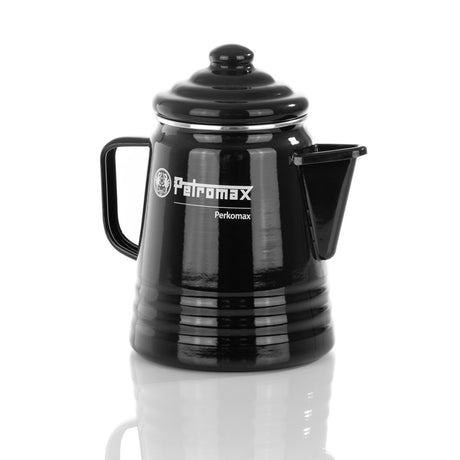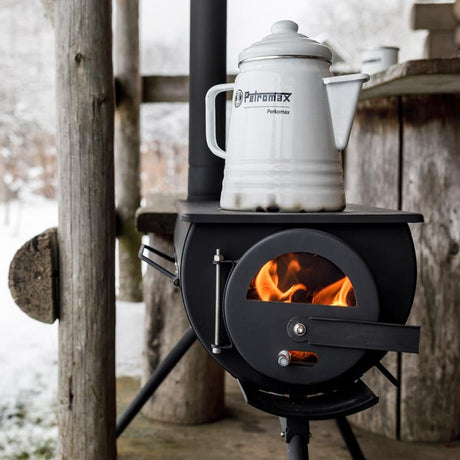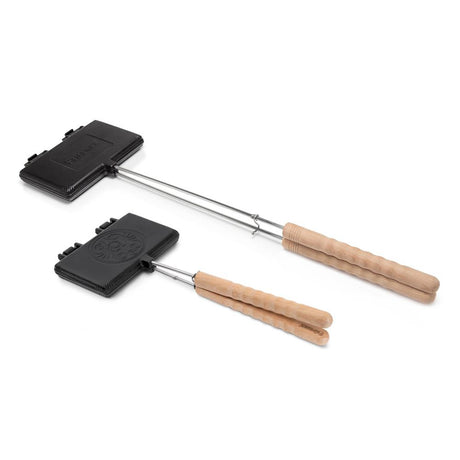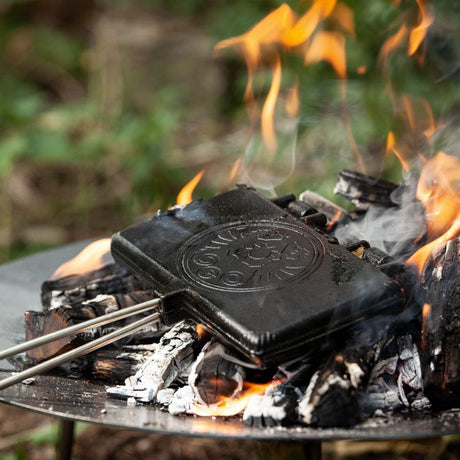Welcome to the ultimate wild garlic guide. This green wonder herb is the secret star of the spring kitchen - aromatic, versatile and super healthy. Do you know that intense garlic scent in the spring forest? That's wild garlic! Whether you already know wild garlic or are hearing about it for the first time - here's everything you need to know!
Table of contents
What is wild garlic anyway?
When and where can you find wild garlic?
How to recognize real wild garlic (and not confuse it!)
Harvesting wild garlic - but the right way!
The best uses in the kitchen
Health benefits of wild garlic
Preserving and storing wild garlic
Conclusion
What is wild garlic anyway?
Wild garlic (scientific name: Allium ursinum) is a wild garlic plant, also known as "wild garlic" or "wild garlic". It belongs to the allium family, just like onions, chives and, of course, garlic. Incidentally, the name comes from the fact that bears supposedly like to eat wild garlic after hibernation to detoxify themselves - no one really knows whether this is true, but it sounds cool! In some regions, it is also called "witch's onion" or "ramson", which shows how deeply rooted this plant is in our culture.
In contrast to normal garlic, the leaves are mainly used in wild garlic. Although they taste a lot like garlic, they are much milder and finer in flavor. Good to know: The intense aroma does not linger on the breath as long as with normal garlic. So if you like garlic but don't fancy garlic breath that lingers for days, wild garlic is your new best friend!
The young, tender leaves taste best - the older they get, the more intense and sometimes bitter the taste becomes. Incidentally, you can also eat the flowers and buds, which have a slightly peppery flavor and look fantastic in salads or as a garnish.
When and where can you find wild garlic?
Wild garlic is a real spring plant! The best time to find it is from March to May. It is one of the first heralds of spring and often appears when the rest of the forest is still in hibernation. From March to May, you'll find it mainly where it's nice and shady and damp. Typical places are:
- Moist deciduous forests (especially under beech trees)
- Streams and river meadows
- Shady forest edges
Wild garlic loves chalky soils and thrives particularly well in regions with a mild climate. In some areas, it grows so abundantly that you literally stumble across whole carpets of wild garlic - especially in southern Germany, Austria and Switzerland, there are true wild garlic paradises. Once you've found one of these places, you can smell it from afar - there's a distinct garlic scent in the air that practically leads you by the nose to where you've found it.
By the way: If you don't know any good collection points in your area, ask on local Facebook groups or try out special wild herb apps. There are now even wild herb walks where experienced herb experts show you not just wild garlic, but a whole range of wild plants.
How to recognize real wild garlic (and not confuse it!)
Now comes the most important part: wild garlic can be confused with poisonous plants, especially lily of the valley and autumn crocus. This confusion should not be underestimated - the autumn crocus in particular contains the poison colchicine, which can be life-threatening even in small quantities. Sounds dramatic, but don't worry: with a little knowledge, you can safely recognize wild garlic!
So here are the characteristics that will help you recognize real wild garlic:
- Smell test: Rub a leaf between your fingers - real wild garlic smells intensely of garlic!
- Leaves: Wild garlic leaves are elongated and oval, have a recognizable stem and a matt underside. If you look closely, you will see that each leaf grows out of the ground individually, whereas lily of the valley often has two leaves together.
- Stem: The stem is triangular and not round, if you roll it between your fingers you can feel the edges.
- Flowers: The white, star-shaped flowers grow in umbels (from April/May) and look upwards, whereas lily of the valley flowers hang downwards in a bell shape.
- Leaf underside: The underside of wild garlic leaves is matt, while theunderside of lily of the valley leaves is shiny.
IMPORTANT: If you're not 100% sure, leave it alone! If in doubt, buy from the supermarket or weekly market - it's not as adventurous, but it's safer. Many organic farms and weekly markets now also offer fresh wild garlic, often even in organic quality.
Harvesting wild garlic - but the right way!
If you want to collect wild garlic, take a basket or cloth bag with you (it sweats and gets muddy in plastic bags). Here are our tips for sustainable picking:
- Never take all the plants from one place - always leave enough!
- Cut the leaves carefully with scissors instead of tearing them out
- Only take as much as you can really handle
- Avoid areas directly next to roads or dog-walking paths (for obvious reasons...)
By the way: collecting wild garlic is usually prohibited in nature reserves - check beforehand whether you are in a permitted zone!
The best uses in the kitchen
Now it's getting tasty! Wild garlic is an absolute all-rounder in the kitchen and the best thing about it: you don't need to be a star chef to conjure up fantastic dishes with it. The fresh leaves have a wonderfully aromatic flavor that delights garlic lovers, but is also often acceptable to garlic skeptics because it is so much milder and subtler. Here are our favorite uses:
Wild garlic pesto (the classic!)
Wild garlic leaves, pine nuts, parmesan, good olive oil and a little salt - the green dream is ready! For a really tasty pesto, I use about 100g fresh wild garlic, 50g pine nuts (alternatively, walnuts or sunflower seeds work too), 50g freshly grated Parmesan and about 100-150ml good olive oil. Puree everything in a blender, season with salt - done! This pesto tastes great with pasta, as a spread on bread or to refine soups. It will easily keep for 1-2 weeks in the fridge in a clean jar covered with a little oil.
Wild garlic butter
Mix soft butter with finely chopped wild garlic and a little salt. I take about 250g butter (room temperature) and mix it with 2-3 handfuls of chopped wild garlic, a pinch of salt and sometimes a little lemon zest for an extra kick. Spread this butter on fresh baguette and bake in the oven - heavenly! Or imagine a juicy steak coming off the grill with a dollop of this aromatic butter on top... Simply amazing!
Wild garlic in soups and stews
Simply add a few chopped leaves to your potato soup or vegetable stew just before the end of the cooking time - it adds a delicious flavor! Wild garlic goes particularly well with potato dishes of all kinds. My absolute insider tip: a creamy potato and wild garlic soup with a little cream and freshly grated Parmesan on top. It's pure springtime bliss in a bowl!
Wild garlic quark
The perfect dip for barbecues: Low-fat quark with chopped wild garlic, a little lemon juice, salt and pepper - that's it! If you like it creamier, you can also stir in a spoonful of sour cream or sour cream. This dip goes perfectly with grilled vegetables, meat or simply with fresh farmhouse bread. This dip is always the first thing to go at barbecues!
Wild garlic oil
Puree the wild garlic with good olive oil and pour through a fine sieve. The oil will keep in the fridge for about 2 weeks and will spice up any dish. A few drops of it over grilled vegetables, pasta or a simple tomato soup - and you have a dish with the wow factor! Incidentally, this oil also makes a great little gift or present in a pretty bottle.
TIP: Only ever cook wild garlic briefly or use it raw - otherwise the delicate aroma will be lost!
Health benefits of wild garlic
Wild garlic is not only delicious, but also really healthy! Even our grandparents knew about the healing power of this plant - it is not for nothing that wild garlic is also known as "wild garlic" and shares many health benefits with its relative.
Like its culinary cousin, garlic, it contains many healthy sulphur compounds, especially allicin, which is produced when the leaves are crushed. These bioactive substances provide:
- Support the immune system (perfect during cold season!)
- Positive effect on blood pressure and cholesterol levels
- Antibacterial properties
- Promotion of digestion
- Detoxifying effect on the body
Wild garlic also contains an amazing amount of vitamin C (more than lemons!), iron, manganese and other important minerals and trace elements. The antioxidants it contains can help fight free radicals in the body and thus prevent cell damage.
A small side note: in traditional folk medicine, wild garlic was also recommended for rheumatism and arthritis. Whether this is scientifically valid remains to be seen - but it shows how versatile this plant has been for centuries.
Preserving and storing wild garlic
The wild garlic season is unfortunately quite short - you have the chance to harvest the green gold from March to May. But don't worry, with a few tricks you can significantly prolong your wild garlic enjoyment and save a piece of spring for later:
- Freeze: Wash the leaves thoroughly, pat dry (dry really well, otherwise ice crystals will form), cut into small pieces and freeze in ice cube trays with a little water or oil. You can simply add the wild garlic ice cubes to soups or sauces later.
- Drying: It works, but wild garlic loses a lot of its aroma and the characteristic taste unfortunately evaporates for the most part. If you still want to try it: hang the leaves loosely and leave to dry in an airy, shady place. Then put them in airtight containers.
- Wild garlic salt: Finely chop the dried leaves or chop them up in a blender and mix with high-quality sea salt in a ratio of 1:4 (1 part wild garlic, 4 parts salt) - lasts forever and gives meat, vegetable and egg dishes a great seasoning! Packaged in pretty little jars, wild garlic salt also makes a great gift for guests.
- Pesto or oil: Prepare as described above and store in the fridge. Important: Always make sure that the surface is covered with oil, then the pesto will keep longer. It will keep for about 2-3 weeks in the fridge and even several months if frozen!
However, wild garlic definitely tastes best fresh - so make the most of the short season! If you have your own garden, you could even consider planting a small bed of wild garlic. It grows quite easily in a shady, moist spot and comes back every year. So you have your own little wild garlic farm right on your doorstep!
Conclusion: Why wild garlic is simply unbeatable
Wild garlic is a real spring gift from nature! Not only does it taste fantastic, but collecting it is also great fun and gets you out into nature. Whether as pesto, in butter or simply raw in a salad - wild garlic adds a great garlic note to your cooking without you smelling of garlic afterwards.
Next time you go for a walk in the woods, keep your eyes peeled! With the knowledge from this article, you'll be able to recognize wild garlic and take your own small harvest home with you. But always remember: only harvest what you really need and leave the roots in the ground so that wild garlic will grow again next year.
Bon appétit and have fun on your wild garlic adventure!
